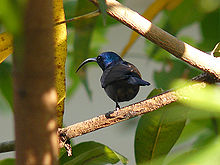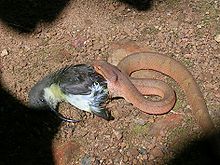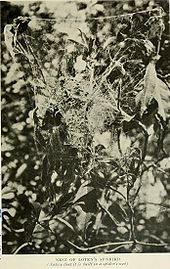- Loten's Sunbird
-
Loten's Sunbird 
Male 
Female Conservation status Scientific classification Kingdom: Animalia Phylum: Chordata Class: Aves Order: Passeriformes Family: Nectariniidae Genus: Cinnyris Species: C. lotenius Binomial name Cinnyris lotenius
(Linnaeus, 1766)Synonyms Nectarinia lotenia
Arachnechthra loteniaThe Loten's Sunbird, Long-billed Sunbird or Maroon-breasted Sunbird, Cinnyris lotenius (formerly placed in the genus Nectarinia), is a sunbird endemic to peninsular India and Sri Lanka. Its long bill distinguishes it from the similar Purple Sunbird that is found in the same areas and also tends to hover at flowers. Like other sunbirds, it feeds on small insects and builds characteristic hanging nests. The species is named after a colonial Dutch governor of Ceylon, Joan Gideon Loten.
Contents
Description
Loten's Sunbirds are small, only 12–13 cm long. The long bill separates this from the syntopic Purple Sunbird. The wings are browner and the maroon breast band is visible on the male under good lighting conditions. The males have pectoral tufts of yellow mixed with crimson that are used in displays.[1] The adult male is mainly glossy purple with a grey-brown belly. The female has yellow-grey upperparts and yellowish underparts, but lacks Purple's faint supercilium. The call is distinctive buzzy zwick zwick and they are also very active often bobbing their head while foraging. They long down-curved bills and brush-tipped tubular tongues, are adaptations to their nectar feeding. The bill lengths vary across populations with the longest bills are found on the east of Peninsular India and in Sri Lanka.[2] The song of the male is a long repeated wue-wue-wue... with the last notes accelerated. The song has been likened to the call of the Cinereous Tit.[2] The males may sing from the tops of bare trees or telegraph wires.
The male in winter has an eclipse plumage with a yellowish underside resembling that of the female but having a broad central streak of dark metallic violet from the chin to the belly.[3][4] The existence of an eclipse plumage in the adult male has been questioned by Rasmussen & Anderton (2005) due to the lack of specimens in evidence. Jerdon noted however that:
A specimen in the Museum As. Soc., Calcutta, has the winter or currucaria plumage of the last, viz., a central glossy green stripe on the throat and breast, and a spot on the shoulders of the wings ; otherwise as in the female. I do not recollect seeing the bird in this plumage in Malabar, where I had many opportunities of observing it, and rather think that it must have been a young bird.
— Jerdon, 1862[5]
Taxonomy
The name of the bird commemorates Joan Gideon Loten, the Dutch governor to Sri Lanka (Ceylon) who commissioned the artist Pieter Cornelis de Bevere to illustrate the natural history of the region from living and collected specimens.[6] The plates by de Bevere included illustrations of many bird species and when Loten went back to England, he loaned these to various naturalists including George Edwards (1694–1773) who used them his Gleanings of Natural History. Carolus Linnaeus described this species under the genus Certhia based on material obtained from Loten.[7]
... described by Linnaeus in the Syst. Naturae, from specimens sent to him by General Loten, Governor of Ceylon, and named in honour of that gentleman, "Habitat in Zeylona. J. G. Loten p. m. Gubernat. Zeylon. qui hortum Botanicum primus in India condidit et tot raris avibus me aliosque dotavit."
— Sir William Jardine [8][9]
Gmelin confused the species with African species and many publications of that time include inaccurate information:
Certhia Lotenia, or Loten's creeper, is a native of Ceylon and Madagascar. It builds its nest of the down of plants, and is subjected to the hostility of a spider in those countries, nearly as large as itself, which pursues it with extreme ardour, and delights in sucking the blood of its young.
— Nicholsons British Encyclopedia, 1819[10]
Distribution and habitat
Found only in peninsular India and Sri Lanka. The main region is along the Western Ghats and into the southern peninsula. There are scattered records from central India and into the northern Eastern Ghats north until Orissa.[11] Race hindustanicus, southern Peninsular populations of which have a slightly shorter bill, is found in India while the nominate race is found in Sri Lanka. They are locally common in both forests, cultivation.[2] They are also common in urban gardens and in some areas such as the city of Madras, they are commoner than other sunbirds.[12]
Behaviour and ecology
The species is resident and no seasonal movements are known. While foraging for nectar they hover at flowers a lot unlike the Purple Sunbirds that prefers to perch beside flowers.[13] Like other sunbirds, they also feed on small insects and spiders.[3]
The breeding season is November to March in India, February to May in Sri Lanka.[14] The nest is built by the female which may however be accompanied by the male.[15] Two eggs are laid in a suspended nest in a tree. The eggs are incubated only by the female for about 15 days. The nest is a bag of webs, bark and caterpillar frass.[16] The nest is built by the female and young are fed by both parents.[17] Nests may sometimes be reused for a second brood.[18] It often builds its nest within the nests of "social spiders" (Eresidae).[3][19]
The nest is usually, not the little hanging structure made by most species, but placed in the large flocculent masses of cobweb spun in low bushes by a certain species of spider. In the interior of the mass the birds press out a more or less globular chamber, lining the walls with vegetable down, and generally providing a little cave of cobweb over the entrance, which is at one side. If spider's webs are not available, they appear on occasions to construct a little pear-shaped, hanging structure like that of the next species.
— W E Wait, 1912[3]
Salim Ali notes that the species is exceptional among Indian sunbirds in not having cobwebs on the exterior.[17]
References
- ^ Oates, EW (1890). The Fauna of British India, Including Ceylon and Burma. Birds Volume 2. Taylor and Francis, London. p. 358. http://www.archive.org/stream/faunaofbritishin02oate#page/358/mode/2up.
- ^ a b c Rasmussen, P. C. & J. Anderton (2005). The Birds of South Asia: The Ripley Guide. Volume 2. Smithsonian Institution and Lynx Edicions. p. 548.
- ^ a b c d Wait,WE. "Passerine birds of Ceylon". Spolia Zeylanica: 22–194. http://www.archive.org/stream/passerinebirdsof00wait#page/184/mode/2up.
- ^ Santharam,V (1981). "Some interesting observations: Eclipse plumage in Loten's Sunbird (Nectarinia lotenia)". Newsletter for Birdwatchers 21 (9&10): 14–15.
- ^ Jerdon TC (1862). The Birds of India. Volume 1. Military Orphan Press, Calcutta. pp. 372–373. http://www.archive.org/details/birdsofindiabein01jerd.
- ^ Cave, Henry W (1908). The book of Ceylon. Cassell & Co.. p. 69. ISBN 9559170465. http://www.archive.org/stream/bookofceylonbein00cave#page/68/mode/2up.
- ^ Raat, AJP (2010). The life of Governor Joan Gideon Loten (1710-1789):a personal history of a Dutch virtuoso. Uitgeverij Verloren. p. 21.
- ^ Jardine, Sir William (1864). The natural history of the Nectariniadae or Sun-birds. Henry G. Bohn, London. p. 220. http://www.archive.org/stream/naturalistslibra05jardrich#page/n263/mode/2up.
- ^ Linnaeus, Carolus (1766). Systema naturae. http://www.archive.org/stream/carolilinnsyste00linngoog#page/n189/mode/1up.
- ^ Anon. (1819). Nicholsons British Encyclopedia. Mitchel Ames White. http://www.archive.org/stream/americaneditiono03nichrich#page/n135/mode/2up.
- ^ Majumdar, N (1981). "Extension of range of the Indian Maroonbreasted Sunbird, Nectarinia lotenia hindustanica (Whistler) [Aves, Nectariniidae], and the Northern Jungle Myna, Acridotheres fuscus fuscus (Wagler) [Aves, Sturnidae]". J. Bombay Nat. Hist. Soc. 78 (2): 383–384.
- ^ Dewar, Douglas (1913). Glimpses of India birds. John Lane, London. p. 218. http://www.archive.org/stream/glimpsesofindian00dewarich#page/218/mode/2up.
- ^ Reuben, Rachel (1986). "Feeding behaviour of Sunbirds, Nectarinia zeylonica and N. lotenia". J. Bombay Nat. Hist. Soc. 83 (2): 446–447.
- ^ Aitken, E. H. (1887). "Nest and eggs of Cinnyris lotenia". J. Bombay Nat. Hist. Soc. 2 (1): 52.
- ^ Ali S & S D Ripley (1999). Handbook of the birds of India and Pakistan. 10 (2 ed.). Oxford University Press. pp. 28–31. ISBN 0195620631.
- ^ Baker HR & CM Inglis (1930). The Birds of Southern India. Government Press, Madras. pp. 125–126.
- ^ a b Ali, Salim (1996). The Book of Indian Birds. Edition 12.. BNHS & Oxford University Press. p. 298.
- ^ Siromoney,G (1977). "Repeated use of a single nest by the Indian Maroonbreasted Sunbird". Newsletter for Birdwatchers 17 (8): 8–9.
- ^ Dewar, Douglas (1912). Jungle Folk: Indian natural history. John Lane, London. p. 175. http://www.archive.org/stream/junglefolkindian00dewa#page/174/mode/2up.
External links
Categories:- IUCN Red List least concern species
- Cinnyris
Wikimedia Foundation. 2010.




